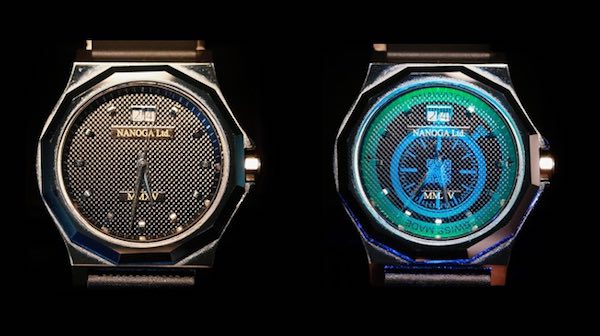
[Image above] A new kind of photonic watermark for anti-counterfeiting efforts is only visible under UV light. Credit: EPFL
Counterfeiting is a big—and lucrative—business.
Although the economic impact of counterfeit goods isn’t easy to calculate, it’s easy to see how pervasive the industry is—if you’ve ever walked the streets of New York City, you’d have a good idea.
Estimates of the total value of fake stuff worldwide soar upwards of $1 trillion every year. And in addition to the money spent trying to identify, catch, and prevent counterfeit goods from entering worldwide markets, all those counterfeit goods equate to a really big impact on genuine products in terms of lost sales.
Watches, jewelry, handbags, and other apparel make up the majority of counterfeit goods that are peddled, or at least those that get seized at borders. While consumer electronics and pharmaceuticals are oft imitated too, watches are one of the biggest sectors of seized counterfeit goods.
But genuine watches and other goods might soon have a fighting chance against counterfeiters, thanks to a new technique developed at École Polytechnique Fédérale de Lausanne that can help sort the fake from the genuine. An EPFL–based startup called Nanoga has patented a system that can create photonic watermarks on ceramic, glass, and metal materials.
Although the process was specifically designed for expensive Swiss watches, it could be used to ensure the origin of manufacture of other products as well.
What makes the technique so powerful is that it doesn’t change the appearance of the product, but rather incorporates an invisible watermark into the material that can only be seen with an ultraviolet light.
So how does it work?
Nanoga uses vapor deposition to deposit its patented chemicals onto a material surface. Then it turns to lithographic printing to activate only areas within the desired pattern to create a UV-light sensitive watermark.
The process can fabricate a thin film of patented chemicals in any desired pattern—whether a large watermark or a barely perceptible serial number.
The technique is not easy to reproduce because of the machinery, expertise, and patented chemicals that together generate the watermark, making it the ideal for anti-counterfeiting efforts.
Speaking of anti-counterfeiting efforts, be on the lookout for the upcoming August issue of the ACerS Bulletin for a cover story about how glass can also be used in another type of anticounterfeiting strategy.
In the meantime, watch the video below to hear more from the EPFL scientists and see the new photonic watermark in invisible action.
Credit: École polytechnique fédérale de Lausanne (EPFL); YouTube
